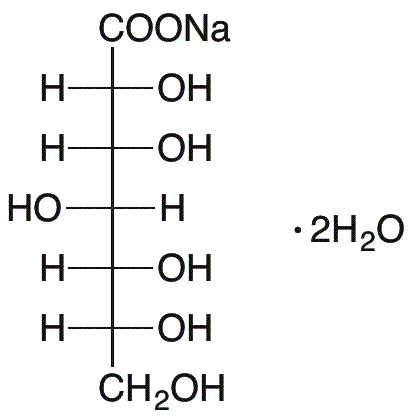Sodium Glucoheptonate dihydrate is widely utilized in research focused on:
- Pharmaceutical Formulations: It serves as a stabilizing agent in drug formulations, enhancing the solubility and bioavailability of active ingredients, which is crucial for effective medication delivery.
- Food Industry: This compound acts as a food additive, improving texture and moisture retention in various products, making it valuable for manufacturers aiming to enhance product quality.
- Cosmetic Products: Sodium Glucoheptonate dihydrate is used in skincare formulations for its moisturizing properties, helping to maintain skin hydration and improve overall skin texture.
- Biotechnology: In laboratory settings, it is employed as a chelating agent in cell culture media, facilitating optimal growth conditions for various cell lines, which is essential for research and development in biotechnology.
- Environmental Applications: It is utilized in bioremediation processes to bind heavy metals, aiding in the detoxification of contaminated environments, thus supporting sustainable practices in environmental science.
General Information
Properties
Safety and Regulations
Applications
Sodium Glucoheptonate dihydrate is widely utilized in research focused on:
- Pharmaceutical Formulations: It serves as a stabilizing agent in drug formulations, enhancing the solubility and bioavailability of active ingredients, which is crucial for effective medication delivery.
- Food Industry: This compound acts as a food additive, improving texture and moisture retention in various products, making it valuable for manufacturers aiming to enhance product quality.
- Cosmetic Products: Sodium Glucoheptonate dihydrate is used in skincare formulations for its moisturizing properties, helping to maintain skin hydration and improve overall skin texture.
- Biotechnology: In laboratory settings, it is employed as a chelating agent in cell culture media, facilitating optimal growth conditions for various cell lines, which is essential for research and development in biotechnology.
- Environmental Applications: It is utilized in bioremediation processes to bind heavy metals, aiding in the detoxification of contaminated environments, thus supporting sustainable practices in environmental science.
Documents
Safety Data Sheets (SDS)
The SDS provides comprehensive safety information on handling, storage, and disposal of the product.
Product Specification (PS)
The PS provides a comprehensive breakdown of the product’s properties, including chemical composition, physical state, purity, and storage requirements. It also details acceptable quality ranges and the product's intended applications.
Certificates of Analysis (COA)
Search for Certificates of Analysis (COA) by entering the products Lot Number. Lot and Batch Numbers can be found on a product’s label following the words ‘Lot’ or ‘Batch’.
Número de catálogo
Número de lote/lote
Certificates Of Origin (COO)
This COO confirms the country where the product was manufactured, and also details the materials and components used in it and whether it is derived from natural, synthetic, or other specific sources. This certificate may be required for customs, trade, and regulatory compliance.
Número de catálogo
Número de lote/lote
Safety Data Sheets (SDS)
The SDS provides comprehensive safety information on handling, storage, and disposal of the product.
DownloadProduct Specification (PS)
The PS provides a comprehensive breakdown of the product’s properties, including chemical composition, physical state, purity, and storage requirements. It also details acceptable quality ranges and the product's intended applications.
DownloadCertificates of Analysis (COA)
Search for Certificates of Analysis (COA) by entering the products Lot Number. Lot and Batch Numbers can be found on a product’s label following the words ‘Lot’ or ‘Batch’.
Número de catálogo
Número de lote/lote
Certificates Of Origin (COO)
This COO confirms the country where the product was manufactured, and also details the materials and components used in it and whether it is derived from natural, synthetic, or other specific sources. This certificate may be required for customs, trade, and regulatory compliance.


